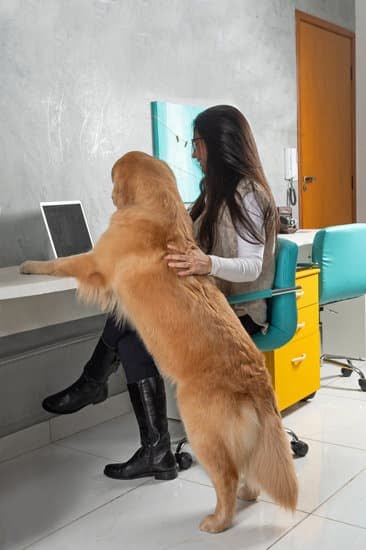Does your dog have a habit of wandering around the house, getting underfoot, or taking over the couch? Perhaps it’s time to teach her a valuable skill – how to go to her bed on command. In this article, we will explore the importance of training your dog to go to her bed and provide practical tips and techniques for successfully teaching this behavior.
Creating a comfortable and inviting space for your dog to rest is an essential aspect of their overall well-being. By teaching your dog to go to her bed, you can help establish a designated area where she feels safe, secure, and relaxed. This can also be incredibly useful in managing her behavior and promoting a harmonious living environment for both you and your furry companion.
Training your dog to go to her bed involves more than just pointing at a spot and expecting her to understand. It requires clear communication, consistent cues, and positive reinforcement.
In the following sections, we will walk you through the process of teaching the “Go to Bed” command, using rewards and redirection effectively, and maintaining patience and consistency throughout the training process. Whether you’re dealing with a puppy or an older dog, these techniques can be adapted to suit different personalities and learning styles.
Creating a Comfortable and Inviting Bed Space for Your Dog
- Choose the right bed: Select a bed that is appropriate for your dog’s size and age, with enough cushioning and support. Consider whether your dog prefers a flat surface or something more cozy like a cushioned bolster bed.
- Location, location, location: Place the bed in a quiet, low-traffic area of your home where your dog can have their own space without feeling isolated. This could be in the corner of the living room or in your bedroom where they can still feel close to you.
- Add familiar scents: Introduce familiar scents into the bed area such as a blanket or toy that smells like you or your dog’s favorite treat. This will help create an association of comfort and security with their bed.
- Create a routine: Dogs thrive on routines, so establish a bedtime routine that includes going to their bed. For example, give them a treat when they go to their bed at night and use the same phrase each time, such as “go to bed.”
By following these steps, you can create a comforting environment for your dog’s bed space, making it more likely for them to willingly go to their designated area when given the command.
Teaching Your Dog the Go to Bed Command
Understanding the Importance of the Go to Bed Command
Training your dog to go to her bed is not just about having a designated resting area for your pet, but it also serves as a valuable skill that can be used in various situations. Whether you have guests over, need your dog to stay in one place for safety reasons, or simply want to establish boundaries, teaching your dog the go to bed command can be incredibly useful for both you and your furry friend.
Creating a Comfortable Bed Space
Before you begin training your dog to go to her bed, it’s important to ensure that her bed space is comfortable and inviting. Choose a location in your home that is quiet and away from heavy foot traffic or noise. Invest in a bed that provides adequate support and comfort for your dog’s size and breed. Adding familiar toys or blankets can also make the bed area more appealing and cozy for your pet.
How to Train Your Dog to Go to Her Bed
The actual process of teaching your dog the go to bed command involves consistent repetition and positive reinforcement. Start by using treats or toys as incentives for your dog to go towards her designated bed space when prompted with the command. It’s crucial to remain patient and consistent during this training process.
Gradually phase out the use of treats as your dog becomes more accustomed to responding to the command. Be sure to always use a calm and firm tone when giving the instruction, and avoid showing frustration if progress is slow at first. Remember that each dog learns at their own pace, so it’s important not rush or force the process.
By following these steps on how to train your dog to go to her bed, you can effectively teach this useful command while building trust and communication with your furry companion.
Using Positive Reinforcement and Rewards
When training your dog to go to her bed, using positive reinforcement and rewards can be a highly effective method. Dogs respond well to positive feedback, and this approach can help reinforce the desired behavior of going to her bed when commanded. Positive reinforcement involves rewarding your dog for good behavior, which encourages her to repeat that behavior in the future.
One way to use positive reinforcement is by giving your dog a treat or verbal praise when she goes to her bed on command. This signals to her that she has done something right and will likely encourage her to do it again. Make sure that the reward you give is something that your dog finds highly motivating, such as a favorite treat or toy.
Another method of positive reinforcement is clicker training, where you use a clicker device to immediately mark the moment your dog performs the desired behavior. This is then followed by a reward, which helps strengthen the association between the action and the reward. Over time, this can lead to your dog reliably going to her bed when prompted.
Consistency is key when using positive reinforcement and rewards in training your dog to go to her bed. Always reward her promptly after she follows the command, so she associates going to her bed with receiving a reward. With patience and consistency, you can effectively train your dog using this method.
| Training Method | Description |
|---|---|
| Positive Reinforcement | Rewarding good behavior with treats or praise |
| Clicker Training | Using a clicker device to mark desired behavior followed by a reward |
| Consistency | Consistently rewarding prompt obedience of the command |
Correcting and Redirecting Unwanted Behavior
Identifying Unwanted Behavior
Before you can correct and redirect your dog’s unwanted behavior, it’s important to identify what specific actions or habits you want to address. This could include your dog refusing to go to her bed when commanded, getting up from her bed without permission, or exhibiting anxious or hyperactive behavior while on her bed.
Using Calm and Assertive Communication
When correcting unwanted behavior, it’s crucial to use a calm and assertive tone with your dog. Yelling or reacting with frustration can actually exacerbate the problem and create more stress for your pet. Instead, focus on using a firm voice and body language that conveys authority without aggression.
Redirecting Behavior Towards the Bed
If your dog repeatedly tries to leave her bed or exhibit other unwanted behaviors, gently but firmly guide her back to the bed space. You can use a leash, if necessary, to lead her back to the designated area. Once there, reinforce the “go to bed” command and provide positive reinforcement when she complies.
By consistently correcting and redirecting unwanted behavior while training your dog to go to her bed, you can effectively communicate expectations and establish boundaries in a way that is both firm and compassionate. Remember that all dogs learn at their own pace, so patience and ongoing reinforcement will be key in achieving success in this training process.
Consistency and Patience in Training
Training your dog to go to her bed requires consistency and patience. Dogs, like humans, need time to learn new behaviors and commands, so it’s important to be patient throughout the training process. Additionally, consistency in your training methods and expectations is crucial for effectively teaching your dog to go to her bed on command.
To effectively train your dog to go to her bed, consider the following tips for maintaining consistency and patience:
1. Establish a regular training schedule: Set aside dedicated time each day for training sessions with your dog. Consistency in the timing and frequency of these sessions can help reinforce the go-to-bed command.
2. Use consistent cues and commands: Choose a specific cue or command, such as “Go to bed,” and use it consistently during training sessions. This will help your dog associate the cue with the desired behavior.
3. Be patient with progress: Every dog learns at their own pace, so it’s important to remain patient and avoid becoming frustrated if your dog doesn’t grasp the concept right away. Celebrate small achievements and progress along the way.
4. Stay calm and positive: Dogs are sensitive to their owner’s emotions, so maintaining a calm and positive demeanor during training sessions can have a significant impact on your dog’s willingness to learn.
By implementing these strategies for consistency and patience in training, you can effectively teach your dog how to go to her bed on command while strengthening the bond between you and your furry companion. With time, practice, and dedication, you will see positive results in your dog’s ability to follow this important command.
Tips for Troubleshooting Common Challenges
When training your dog to go to her bed, you may encounter some common challenges along the way. It’s essential to be prepared for these obstacles and have a plan in place for how to address them effectively.
One of the most common issues is that your dog may not want to stay on her bed, especially if she is accustomed to being near you at all times. In this case, it’s important to remember that consistency and patience are key.
Another challenge you may face is getting your dog to go to her bed when there are distractions present. For example, if there are other pets in the household or visitors come over, your dog may struggle to focus on following the command. To address this challenge, it can be helpful to practice the “go to bed” command in various situations and gradually increase the level of distraction while reinforcing the behavior with positive reinforcement and rewards.
Additionally, some dogs may exhibit anxious or fearful behavior when asked to go to their bed. This could be due to a negative association with the bed or an underlying anxiety issue.
It’s important to work with a professional trainer or behaviorist if you notice signs of distress in your dog when attempting to train her. By addressing these challenges with patience, understanding, and consistent training methods, you can help your dog overcome these obstacles and successfully learn how to go to her bed on command.
Incorporating Go to Bed Into Daily Routines and Activities
Once your dog has mastered the “go to bed” command, it’s important to incorporate this into your daily routines and activities. This not only reinforces the training but also provides a consistent and clear expectation for your dog. One way to do this is by making her bed space a part of her daily routine, such as having her go to her bed before mealtimes, when guests arrive, or when it’s time for you to leave the house.
Another way to incorporate the “go to bed” command into daily activities is by using it during obedience training sessions, playtime, or when engaging in interactive activities with your dog. For example, if you are practicing recall exercises at the park, incorporate the “go to bed” command as part of the routine before rewarding her with playtime or treats.
Consistency is key when incorporating the “go to bed” command into daily routines and activities. By consistently reinforcing this behavior, you are helping your dog understand that going to her bed is an expected part of her daily life. Over time, she will come to see her bed as a safe and comfortable space that she willingly goes to on command.
By incorporating “go to bed” into daily routines and activities, you are not only solidifying the training but also providing your dog with a sense of structure and predictability in her day-to-day life. This can lead to a happier and better-behaved pet overall.
| Benefits | How to Incorporate |
|---|---|
| Reinforces Training | Make Her Bed Space Part of Daily Routine |
| Provides Structure | Use Command During Obedience Training Sessions |
| Predictability | Create Consistency in Expectations |
Maintaining and Reinforcing Training Over Time
In conclusion, training your dog to go to her bed is a valuable skill that can benefit both you and your furry friend. By understanding the importance of this training and creating a comfortable bed space, you set a foundation for success. Teaching the “go to bed” command and using positive reinforcement and rewards can make the training process enjoyable for your dog.
Consistency and patience are key when training your dog to go to her bed. It’s important to correct and redirect any unwanted behavior while also troubleshooting common challenges that may arise. Additionally, incorporating the “go to bed” command into daily routines and activities can help reinforce the training over time.
Remember, maintaining and reinforcing the training is crucial for long-term success. By staying consistent with your expectations and being patient with your dog, you can ensure that she continues to respond to the “go to bed” command effectively. With dedication and effort, you can train your dog to go to her bed in no time.
Frequently Asked Questions
Why Won’t My Dog Go in Her Bed?
Your dog may not want to go in her bed for a variety of reasons. She might not find it comfortable, it could be placed in an undesirable location, or she may have negative associations with the bed.
How Do I Get My Dog to Use His Bed?
To get your dog to use his bed, you can try making it more appealing by placing his favorite toys or treats in it. You can also provide positive reinforcement when he uses the bed on his own.
How Do I Get My Stubborn Dog to Go to Bed?
Getting a stubborn dog to go to bed requires patience and consistent training. Try using positive reinforcement, such as treats or praise, to encourage your dog to go to bed. Establishing a bedtime routine can also help your dog understand when it’s time to sleep.

Welcome to the blog! I am a professional dog trainer and have been working with dogs for many years. In this blog, I will be discussing various topics related to dog training, including tips, tricks, and advice. I hope you find this information helpful and informative. Thanks for reading!





